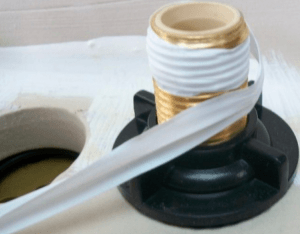Plumbing tape, also known as Teflon tape or PTFE tape, is an essential tool for both professional plumbers and DIY enthusiasts. It’s used to create watertight seals between pipe threads, preventing leaks. If you’re planning to embark on a plumbing project or simply need to fix a dripping tap, understanding how to use this tape effectively can be invaluable. In this guide, we’ll walk you through the steps and offer tips for achieving the best results.

Choose the Right Plumbing Tape
Every successful plumbing project starts with choosing the correct materials. Plumbing tape, also known as Teflon tape, is essential for creating water and gas-tight seals on threaded pipe connections. Before getting started, let’s understand how to select the right tape:
- For Water Connections: The standard white Teflon tape is your best friend when it comes to most household water connections. Designed specifically for water, it provides a watertight seal, ensuring no leakages occur.
- For Gas Connections: If your project involves gas pipes, opt for yellow PTFE tape. This is specially crafted for gas connections, ensuring a tighter seal that prevents any gas leaks.
- Consider Thickness and Density: Not all tapes are created equal. They come in varied densities and thicknesses. For those demanding tasks or high-pressure areas, high-density tapes, which are more durable and robust, are the way to go.
Prepare the Threaded Pipe
A well-prepared surface is the key to an effective application. Before wrapping the tape around:
- Clean the Threads: Ensure the threads are clean and free from old tape, grime, or any foreign particles. Use a brush or cloth to clean it thoroughly. A clean surface ensures better adhesion of the tape, giving you a more secure seal.
Applying the Plumbing Tape
While it seems simple, there’s an art to getting it right:
- Hold Tightly and Wrap Clockwise: Begin by securing the tape’s end on the initial thread. Ensure the tape doesn’t overlap completely but by about half its width as you wrap. This method ensures each thread gets adequate coverage.
- Master the Layering Technique: To achieve the perfect seal, aim to wrap the tape around the threads between three to six times. The pipe size and tape density will influence the exact number of layers.
- Smooth It Out: Once done, press down on the tape, ensuring it snugly fits into the thread grooves.
Test Your Connection
It’s always good practice to check your work:
- Inspect for Leaks: After making the connection, turn on the water or gas. Keep an eye out for any drips or leaks. If you spot any, it’s back to the drawing board. Turn off the supply, add more tape, and try again.
Common Mistakes to Avoid
Forewarned is forearmed. Avoid these pitfalls for a hassle-free experience:
- Over Wrapping: More isn’t always better. Excessive tape can prevent proper threading, leading to potential leaks.
- Remember the Right Direction: It’s crucial to wrap the tape clockwise. If you go counter-clockwise, you risk the tape unwinding when threading.
- Never Skip the Cleaning Phase: The effectiveness of the tape relies heavily on a clean surface. Dirt or remnants of old tape can hinder its ability to create a tight seal.
Frequently Asked Questions
Can I use plumbing tape on plastic pipes?
Yes, it’s suitable for both metal and plastic pipes. Just ensure threads are clean.
How often should I replace the plumbing tape?
Replace it every time you disconnect and then reconnect a threaded pipe.
Is plumbing tape resistant to high temperatures?
Most Teflon tapes can handle up to 500°F (260°C). Always check manufacturer details first.
What’s the difference between white and yellow plumbing tape?
White is for water connections, and yellow is for gas connections.
Does more plumbing tape ensure a better seal?
Not always. Over-wrapping can cause issues like improper threading or bunching, leading to leaks.
Using plumbing tape is a simple yet crucial skill for any DIY plumbing project. By following the steps and tips outlined in this guide, you can ensure a watertight seal for your pipe connections. For those seeking the best plumbing tools and solutions, R.S. Andrews offers a range of plumbing services to suit all your needs. Don’t hesitate to reach out to us for guidance or to tackle more complex plumbing challenges.

